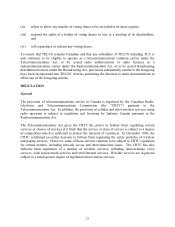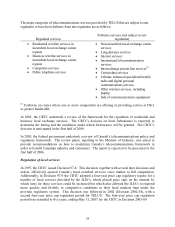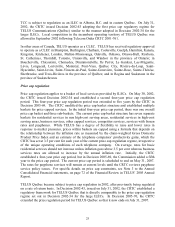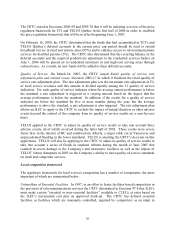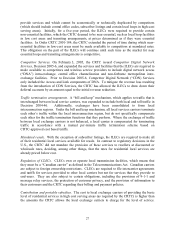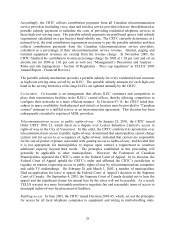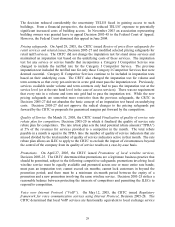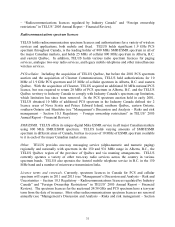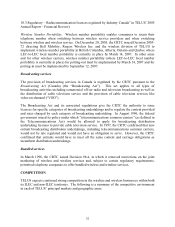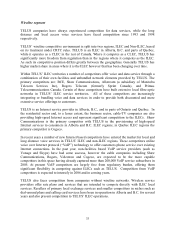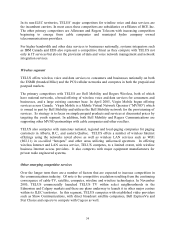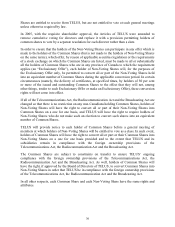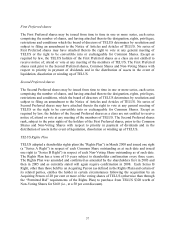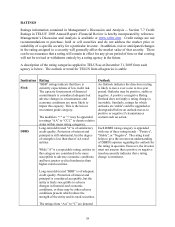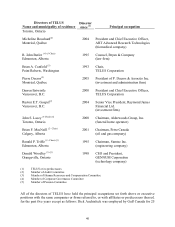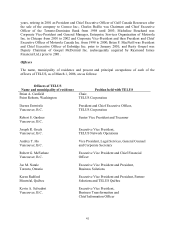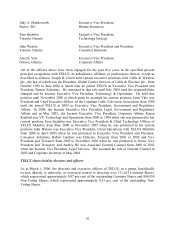Telus 2005 Annual Report Download - page 34
Download and view the complete annual report
Please find page 34 of the 2005 Telus annual report below. You can navigate through the pages in the report by either clicking on the pages listed below, or by using the keyword search tool below to find specific information within the annual report. 33
Wireline segment
TELUS companies have always experienced competition for data services, while the long
distance and local access voice services have faced competition since 1993 and 1998
respectively.
TELUS’ wireline competitive environment is split into two regions, ILEC and Non-ILEC, based
on its treatment under CRTC rules. TELUS is an ILEC in Alberta, B.C. and parts of Quebec,
while it operates as a CLEC in the rest of Canada. Where it competes as a CLEC, TELUS has
significantly more freedom from regulation than in the regions where it competes as the ILEC.
As such its competitive position differs greatly between the geographies. Generally TELUS has
higher market share in areas where it is the ILEC however that has been changing over time.
Within TELUS’ ILEC territories a number of competitors offer voice and data service through a
combination of their own facilities and unbundled network elements provided by TELUS. The
primary competitors are: BCE, Shaw Communications, Allstream (a subsidiary of Manitoba
Telecom Services Inc), Rogers Telecom (formerly Sprint Canada), and Primus
Telecommunications Canada. Certain of these competitors have built extensive local fibre optic
networks in TELUS’ ILEC service territories. All of these competitors are increasingly
integrating or bundling voice and data services in order to provide both discounted and more
extensive service offerings to customers.
TELUS is an Internet service provider in Alberta, B.C., and in parts of Ontario and Québec. In
the residential sector and, to a lesser extent, the business sector, cable-TV companies are also
providing high-speed Internet access and represent significant competition to the ILECs. Shaw
Communications is the primary competitor with TELUS in the provisioning of high-speed
Internet services to consumers in Alberta and B.C. ILEC regions; in Quebec ILEC regions the
primary competitor is Cogeco.
In recent years a number of new Internet based competitors have entered the market for local and
long distance voice services in TELUS’ ILEC and non-ILEC regions. These competitors utilize
voice over Internet protocol (“VoIP”) technology to offer customers phone service over existing
Internet connections. In the past year, non-facilities based VoIP service providers (such as
Vonage and Skype) have had some success, however the cable companies including Shaw
Communications, Rogers, Videotron and Cogeco, are expected to be the more capable
competitors in this space having already captured more than 200,000 VoIP service subscribers in
2005. At present VoIP competitors are largely free from regulatory burden, offering them
significant flexibility in competing against ILECs such as TELUS. Competition from VoIP
competitors is expected to intensify in 2006 and in coming years.
TELUS also faces competition from companies without wireline networks. Wireless service
providers offer rate plans and services that are intended to compete directly with ILEC local
services. Resellers of primary local exchange services and smaller competitors in niches such as
dial-around plans and calling card services have been in operation in Alberta and B.C. for several
years and also present competition to TELUS’ ILEC operations.


